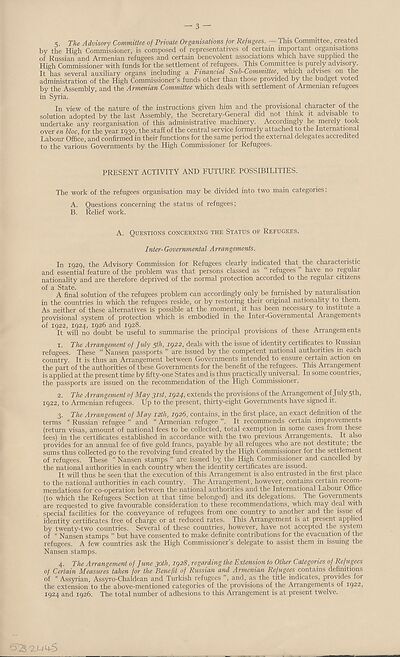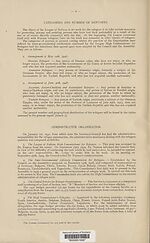Download files
Complete book:
Individual page:
Thumbnail gallery: Grid view | List view

3 —
5. The Advisory Committss of Private Organisatioris for Refugees. — This Committee, created,
by the High Commissioner, is composed of representatives of certain important oiganisations
of Russian and Armenian refugees and certain benevolent associations which have supplied the
High Commissioner with funds for the settlement of refugees. This Committee is purely advisory.
It has several auxiliary organs including a Financial Sub-Committee, "which advises on the
administration of the High Commissioner s funds other than those provided by the budget voted
by the Assembly, and the Armenian Committee which deals with settlement of Armenian refugees
in Syria.
In view of the nature of the instructions given him and the provisional character of the
solution adopted by the last Assembly, the Secretary-General did not think it advisable to
undertake any reorganisation of this administrative machinery. Accordingly he merely took
over en bloc, for the year 1930, the staff of the central service formerly attached to the International
Labour Office, and confirmed in their functions for the same period the external delegates accredited
to the various Governments by the High Commissioner for Refugees.
PRESENT ACTIVITY AND FUTURE POSSIBILITIES.
The work of the refugees organisation may be divided into two main categories:
A. Questions concerning the status of refugees;
B. Relief work.
A. Questions concerning the Status of Refugees.
Inter-Governmental Arrangements.
In 1929, the Advisory Commission for Refugees clearly indicated that the characteristic
and essential feature of the problem was that persons classed as “ refugees ” have no regular
nationality and are therefore deprived of the normal protection accorded to the regular citizens
of a State. , .. .
A final solution of the refugees problem can accordingly only be furnished by naturalisation
in the countries in which the refugees reside, or by restoring their original nationality to them.
As neither of these alternatives is possible at the moment, it has been necessary to institute a
provisional system of protection which is embodied in the Inter-Governmental Arangements
of 1922, 1924, 1926 and 1928.
It will no doubt be useful to summarise the principal provisions of these Arrangements
1. The Arrangement of July 5th, 1922, deals with the issue of identity certificates to Russian
refugees. These “ Nansen passports ” are issued by the competent national authorities in each
country. It is thus an Arrangement between Governments intended to ensure certain action on
the part of the authorities of these Governments for the benefit of the refugees, this Arrangement
is applied at the present time by fifty-one States and is thus practically universal. In some countnes,
the passports are issued on the recommendation of the High Commissioner.
2. The Arrangement of May 31st, 1924, extends the provisions of the Arrangement of July 5th,
1922, to Armenian refugees. Up to the present, thirty-eight Governments have signed it.
3. The Arrangement of May 12th, 1926, contains, in the first place, an exact definition of the
terms “ Russian refugee ” and “ Armenian refugee ”. It recommends certain improvements
(return visas, amount of national fees to be collected, total exemption in some cases from these
fees) in the certificates established in accordance with the two previous Arrangements. It also
provides for an annual fee of five gold francs, payable by all refugees who are not destitute, the
sums thus collected go to the revolving fund created by the High Commissioner for the settlement
of refugees. These “ Nansen stamps ” are issued by the High Commissioner and cancelled by
the national authorities in each country when the identity certificates are issued.
It will thus be seen that the execution of this Arrangement is also entrusted in the first place
to the national authorities in each country. The Arrangement, however, contains certain recom¬
mendations for co-operation between the national authorities and the International Laboui Office
(to which the Refugees Section at that time belonged) and its delegations. The Governments
are requested to give favourable consideration to these recommendations, which may deal with
special facilities for the conveyance of refugees from one country to another and the issue of
identity certificates free of charge or at reduced rates. This Arrangement is at present applied
by twenty-two countries. Several of these countries, however, have not accepted the system
of “ Nansen stamps ” but have consented to make definite contributions for the evacuation of the
refugees. A few countries ask the High Commissioner s delegate to assist them in issuing the
Nansen stamps.
4. The Arrangement of June 30th, 1928, regarding the Extension to Other Categories of Refugees
of Certain Measures taken for the Benefit of Russian and Armenian Refugees contains definitions
of “ Assyrian, Assyro-Chaldean and Turkish refugees ”, and, as the title indicates, provides foi
the extension to the above-mentioned categories of the provisions of the Arrangements of 1922,
1924 and 1926. The total number of adhesions to this Arrangement is at present twelve.
5'3'2-Oi+S
5. The Advisory Committss of Private Organisatioris for Refugees. — This Committee, created,
by the High Commissioner, is composed of representatives of certain important oiganisations
of Russian and Armenian refugees and certain benevolent associations which have supplied the
High Commissioner with funds for the settlement of refugees. This Committee is purely advisory.
It has several auxiliary organs including a Financial Sub-Committee, "which advises on the
administration of the High Commissioner s funds other than those provided by the budget voted
by the Assembly, and the Armenian Committee which deals with settlement of Armenian refugees
in Syria.
In view of the nature of the instructions given him and the provisional character of the
solution adopted by the last Assembly, the Secretary-General did not think it advisable to
undertake any reorganisation of this administrative machinery. Accordingly he merely took
over en bloc, for the year 1930, the staff of the central service formerly attached to the International
Labour Office, and confirmed in their functions for the same period the external delegates accredited
to the various Governments by the High Commissioner for Refugees.
PRESENT ACTIVITY AND FUTURE POSSIBILITIES.
The work of the refugees organisation may be divided into two main categories:
A. Questions concerning the status of refugees;
B. Relief work.
A. Questions concerning the Status of Refugees.
Inter-Governmental Arrangements.
In 1929, the Advisory Commission for Refugees clearly indicated that the characteristic
and essential feature of the problem was that persons classed as “ refugees ” have no regular
nationality and are therefore deprived of the normal protection accorded to the regular citizens
of a State. , .. .
A final solution of the refugees problem can accordingly only be furnished by naturalisation
in the countries in which the refugees reside, or by restoring their original nationality to them.
As neither of these alternatives is possible at the moment, it has been necessary to institute a
provisional system of protection which is embodied in the Inter-Governmental Arangements
of 1922, 1924, 1926 and 1928.
It will no doubt be useful to summarise the principal provisions of these Arrangements
1. The Arrangement of July 5th, 1922, deals with the issue of identity certificates to Russian
refugees. These “ Nansen passports ” are issued by the competent national authorities in each
country. It is thus an Arrangement between Governments intended to ensure certain action on
the part of the authorities of these Governments for the benefit of the refugees, this Arrangement
is applied at the present time by fifty-one States and is thus practically universal. In some countnes,
the passports are issued on the recommendation of the High Commissioner.
2. The Arrangement of May 31st, 1924, extends the provisions of the Arrangement of July 5th,
1922, to Armenian refugees. Up to the present, thirty-eight Governments have signed it.
3. The Arrangement of May 12th, 1926, contains, in the first place, an exact definition of the
terms “ Russian refugee ” and “ Armenian refugee ”. It recommends certain improvements
(return visas, amount of national fees to be collected, total exemption in some cases from these
fees) in the certificates established in accordance with the two previous Arrangements. It also
provides for an annual fee of five gold francs, payable by all refugees who are not destitute, the
sums thus collected go to the revolving fund created by the High Commissioner for the settlement
of refugees. These “ Nansen stamps ” are issued by the High Commissioner and cancelled by
the national authorities in each country when the identity certificates are issued.
It will thus be seen that the execution of this Arrangement is also entrusted in the first place
to the national authorities in each country. The Arrangement, however, contains certain recom¬
mendations for co-operation between the national authorities and the International Laboui Office
(to which the Refugees Section at that time belonged) and its delegations. The Governments
are requested to give favourable consideration to these recommendations, which may deal with
special facilities for the conveyance of refugees from one country to another and the issue of
identity certificates free of charge or at reduced rates. This Arrangement is at present applied
by twenty-two countries. Several of these countries, however, have not accepted the system
of “ Nansen stamps ” but have consented to make definite contributions for the evacuation of the
refugees. A few countries ask the High Commissioner s delegate to assist them in issuing the
Nansen stamps.
4. The Arrangement of June 30th, 1928, regarding the Extension to Other Categories of Refugees
of Certain Measures taken for the Benefit of Russian and Armenian Refugees contains definitions
of “ Assyrian, Assyro-Chaldean and Turkish refugees ”, and, as the title indicates, provides foi
the extension to the above-mentioned categories of the provisions of the Arrangements of 1922,
1924 and 1926. The total number of adhesions to this Arrangement is at present twelve.
5'3'2-Oi+S
Set display mode to:
![]() Universal Viewer |
Universal Viewer | ![]() Mirador |
Large image | Transcription
Mirador |
Large image | Transcription
Images and transcriptions on this page, including medium image downloads, may be used under the Creative Commons Attribution 4.0 International Licence unless otherwise stated. ![]()
| League of Nations > International > Russian, Armenian, Assyrian, Assyro-Chaldean and Turkish refugees > (3) |
|---|
| Permanent URL | https://digital.nls.uk/195214536 |
|---|
| Shelfmark | LN.XII |
|---|
| Description | Over 1,200 documents from the non-political organs of the League of Nations that dealt with health, disarmament, economic and financial matters for the duration of the League (1919-1945). Also online are statistical bulletins, essential facts, and an overview of the League by the first Secretary General, Sir Eric Drummond. These items are part of the Official Publications collection at the National Library of Scotland. |
|---|---|
| Additional NLS resources: |
|

